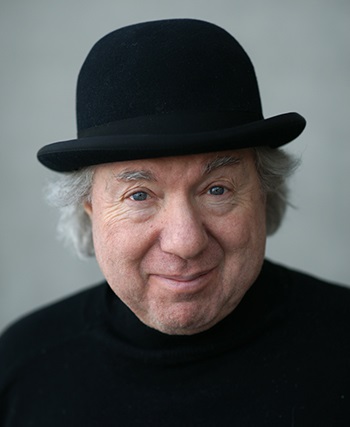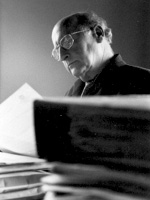50 years at the Logos Foundation
Challenging von Hornbostel & Sachs
Logos Foundation and the making of musical instruments beyond any category
Ignace De Keyser
Challenging von Hornbostel & Sachs
Logos Foundation and the making of musical instruments beyond any category by Ignace De Keyser
Von Hornbostel & Sachs and their challengers on epistemological grounds
Von Hornbostel and Sachs Systematik der Musikinstrumente. Ein Versuch [hereafter: vHSC], a classification system for musical instruments now largely accepted by scholars, was published in 1914. vHSC relied, as far as the main classes are concerned, on the fourfold classification of Victor-Charles Mahillon, director of the Mahillon Company, Belgium’s largest brass and woodwind musical instruments factory of the 19th Century, and first curator of the Brussels Musical Instruments Museum [MIM]. In his 1878 published Essai de classification méthodique de tous les instruments anciens et modernes, Victor Mahillon indeed defined authophones [latter called idiophones], membranophones, chordofones and aerophones on acoustical grounds and divided them into several levels of sub-classes. von Hornbostel and Sachs stressed on Mahillon’s ‘acoustically based’ definitions for the main classes, and they developed their sub-classes mostly on morphological criterions.
Backhaus [Über den Stand der Forschung auf dem Gebiet der physikalischen Akustik (1938)], and Herbert Heyde [Grundlagen des natürlichen Systems der Musikinstrumente (1975)] challenged the acoustical criteria used in vHSC, and considered them to be inconsistent. According to Backhaus one should compare aerophones with idiophones: Finally, aerophones were treated as a special class, although, according to the current principles, they should be classified among the idiophones [Schließlich werden „Aerophone“ als besondere Klasse behandelt, obgleich man sie nach den bisherigen Grundsätzen zu den Idiophonen rechnen müßte. Heyde considers membranes, strings and solid bodies as converters of energy or Wandler which convert incoming energy into an energy format that can be perceived – directly or indirectly – by human beings. In wind instruments, these converters are threefold: the edge of a flute on which turbulences are produced, through a steady wind stream [Acialia], the mechanical vibrations of a reed on reed instruments [Lingualia], and those of a lip reed [Labialia]. Remarkably, even Mahillon had put forward a different definition of the aerophones than the one given by his successors, von Hornbostel and Sachs. Mahillon’s successors consider the acoustical parameter in aerophones as: the air itself [being ] in the first place set into vibration [Die Luft selbst gerät primär in Schwingung], Mahillon, more precisely, had defined them as the instruments where the sound is produced by the vibratory motion of the air, obtained by means of an air stream acting on specific components [où le son est produit par le mouvement vibratoire de l'air, obtenu à l'aide d'un courant agissant sur des organes spéciaux ]. In aerophones, according to Mahillon, the air is thus not a generator of sound, but the driving energy, and the medium in which the converters are acting, these converters being an edge, a reed and a lip reed. Mahillon rightly calls these three convertors of energy organes spéciaux – and he already mentions them in his Eléments d’acoustique published in 1874, three years before the first publication of his Essai. In fact, 100 years later, Herbert Heyde did only confirm the relevance of Mahillon’s definition of organes spéciaux in aerophones.
Especially at the demand of ethno-organologists, who were in search of relevant parameters in classifying extra-European musical instruments, but also of specialists in specific domains in organology, taxonomies of musical instruments were being developed. According to Margaret Kartomi [On Concepts and Classifications of Musical Instruments (1990)], a taxonomy consists of a set of taxa, or groupings of entities that are determined by the culture or group creating the taxonomy. Several other authors have established a typology or even a taxonomy for certain subclasses, on Batak musical instruments, Are’ Are classification, Western wind instruments, flutes worldwide, Swedish wooden trumpets, Finnish pastoral aerophones, among others. In order to avoid conflicting criteria, others started from the plurality of criteria, and tried to reorganize them in a rational way: André Schaeffner (1932), Hans-Heinz Draeger (1948 & 1957), Kurt Reinhard (1960), Michael Ramey (1974), William Malm (1974), Herbert Heyde (1975), René Lysloff and Tim Matson (1985), Tetsuo Sakurai (1980), Sumi Gunji (1996), Peter Simon (2004). Some of them authors, quite naturally, have evolved towards a faceted classification, in which the same species can be classified according to different sets of criterions into matrixes.
Logos Foundation challenging vHSC
In the first instance, Logos Foundation joined non-conformist musical currents like bruitismus, atonalism, aleatorism, happening etc., and applied such experimental traits in their production, with fac-similes of Russolo’s intonarumori, noise boxes, Singing Bicycles, among others, by Godfried Willem Raes, and in audio-art by Moniek Darge and Laura Maes - see http://www.logosfoundation.org/projects.html (accessed 15 June 2018).
Some years ago, Godfried showed to the present author one of the automatons he had developed and that he had called “Hybr” - from “Hybrid” instrument. He proudly announced that this instrument would challenge von Hornbostel and Sachs’ classification system of musical instruments [vHSC]. In Godfried’s own words, “the instrument belongs to the category of the organ [stops]. In traditional organ building, membrane driven pipes have been used occasionally in the 19th century, e.g. the diaphone stop. [‘Hybr’] however, is quite different and offers many more possibilities, as the resonance of the pipes can be fully controlled through electronic means. An important advantage over any other organ-type instrument is that [it allows] a very broad control over dynamics, the tuning of the pipes being independent of wind pressure. The global sound volume can be controlled as well, and [also] the individual loudness of each individual pipe. Moreover, our implementation makes it possible to use the instrument in just about any imaginable tuning system, as each pipe can be detuned a quartertone up or down referred to equal [temperament].
The diaphone stop has indeed been invented by Robert Hope-Jones in 1894 and was applied in the following years a.o. on the organs of Worcester Cathedral and of Edinburgh’s McEwan Hall. The foghorn, used in lighthouses, is a patented variant of it. Even the diaphone stop has only be integrated in the vHSC during the MIMO revision of this system in 2011, as category 424 [https://de.wikipedia.org/wiki/Membranopipe - accessed 15 June 2018]. So it is not surprising that Godfried's 'Hybr' has not yet find its place in the MIMO revision of vHSC – see http://www.mimo-international.com/MIMO/ [accessed 15 June 2018; MIMO is an acronym for an EU founded project called Musical Instruments Museums Online].
Combination instruments and Logos Robots Orchestra
In von Hornbostel and Sachs classification system, it is of course possible to include combination instruments, by joining different subclasses. The first who mentioned this being a problem is Jeremy Montagu in the 1971 article that he wrote with John Burton on A Proposed New Classification System for Musical Instruments. They give the example of a highland pipe, which would require the use of 24 figures and signs: 422.112/422.211.1.-621 and, apparently, they are very kind to the von Hornbostel & Sachs’ system. As Jeremy Montagu and John Burton rightly concludes, the systematic is constructed, not as a classification […] but as a key. In a certain way, a key situation is comparable to the Universal Decimal Classification (UDC) used for scientific literature and in libraries, where whatever subject of human knowledge can be classified using a combination several Dewey codes, and extra suffixes and special codes for geographic, linguistic and cultural entities.
Nevertheless, combination instruments do present a serious problem in a hierarchical classification system for musical instruments, as both Mahillon’s classification system and vHSC were intended to be, since they make irrelevant the existence of major the fourfold classification mentioned above. Relatively simple examples are tambourines in which a shaken rattle (idiophone) is combined with a frame drum (membranophone), but non-Europeans musical instrument represent dozens of them, a.o. buzzers (idiophones) on lyres and harps (chordophones), on drums and even on other idiophones such as slit drums and lamellaphones [Central African sanza and on drums]. Problems become even bigger with (barrel) organs, and especially with the famous large dance organs such as the ones made by the Belgian organ builder Mortier (Antwerp), and the Logos Robots Orchestra, created and build by Godfried-Willem Raes. Such instruments, that include musical instruments from all main classes (sometimes even including the newly added 5th class of electrophones), cannot be integrated in any phylogenetic classification system, built upon one of these classes. As automated, programmable or program-controlled mechanical instruments they rather constitute a grade in the evolution of mechanical instruments, with early concussion and percussion mechanics (beaters), and mechanical interfaces (bows and keyboards) as earlier evolutionary steps.
An analogous problem arose for electrophones, which constitute a further grade in the evolution of musical instruments as well. In 2010, in order to review the vHSC, Maarten Quanten, who had consulted Logos Foundation’s productions, and Godfried’s expertise, concluded that the modular nature of these instruments clearly contradicts the disposition of the classification system, which is fundamentally hierarchic, root-based. Significant differences and similarities between electronic and hybrid configurations cannot be shown in a tree taxonomy. An electronic or electric instrument is an assemblage; its instrumental features depend upon the specificity of the parts, the way in which they are linked, and the way the user can command them. Links between instruments can occur between all of these parts, micro- and macro assemblages […] . The exclusive use of a single H-S code cannot possibly show the convergences and divergences between these four devices. And as “linking” was one of the aims of Hornbostel and Sachs, it would be quite unscientific to ignore the contradiction between the nature of the instruments and the nature of the classification system [Yearbook for Traditional Music 2011 (43)]. However, a version without the modular approach proposed by Maarten Quanten was developed, and is currently being used by MIMO as a fifth category of the revised vHSC scheme - see class 5 ‘Electrophones’ in http://www.mimo-international.com/documents/Hornbostel%20Sachs.pdf [accessed 15 June 2018] .
Post-Scriptum: a DNA for musical instruments ?
With regard to evolutionary processes, we may ask what exactly the mechanisms in the evolution of musical instruments are. Cultural artifacts are not reproduced through a genetically transmitted code, but new instruments can indeed be variants of existing species, that are produced by hazard (sometimes called a creative process) and that are more adapted to a changing environment than their predecessors. In Western music, tonality, an organisation chart for tone intervals, on the one hand, and an interface, called keyboard, on the other, are of paramount importance for the evolution of both music production and the making of musical instruments. In opposition with modes, pentatonic tone series, maqams, tonal raga’s, among others, tonality not only allows the production of melodies, but also of melodic progression, harmony, and harmonic polyphony. The use of keyboards is intimately linked with the increased opportunities presented by tonality and materializes them in a practical and intuitive way. The evolutionary success of a keyboard in Western art music culture is evident: today some 21 different species of keyboard instruments exist. Following Richard Dawkins’ definition of memes in his The Selfish Gene (1982), tonality schemes and keyboard interfaces could perhaps been seen as such. In Consciousness explained, (1991) Daniel Dennett makes clear that “meme evolution is not just analogous to biological or genetic evolution, not just a process that be metaphorically described in these evolutionary idioms, but a phenomenon that obeys the laws of natural selection exactly. In that case, both tonality and keyboards indeed, come to the fore.
A good example of the evolutionary success of the keyboard in Western music is that of the Hammond organ over the Therminvox. Both Laurens Hammond (1895-1973) and Lev Thermin (1896-1993) invented a new electronic instrument: the Hammond organ is an improved application of tone wheels , the Therminvox a newly invented ring modulator used as a sound source – and, by the way, a basis for later generations of electronic devices. Both inventors could rely on comparable marketing opportunities: Hammond had its own Clock Company, Thermin was supported by the new Soviet government in a first stage, and, after his settlement in the USA, by the RCA Company who produced his instrument from 1928 onwards. A Hammond organ uses a keyboard as an interface; the Therminvox a radio control device “in the air”. A Hammond organ was soon accepted in jazz, as a replacement of a church organ, or as a home organ, the Therminvox, intended for use in alternative orchestras imagined by the inventor, has almost exclusively been heard in thriller movies and the like. The keyboard proved to be the fittest.
Conformism is the main reason why cultural traditions are maintained within populations. Boyd and Richerson (Why culture is common, but cultural evolution is rare. Proceedings of the British Academy, 1996/88) showed that a tendency to acquire the most common behavior exhibited in a society was adaptive in a simple model of evolution in a spatially varying environment, because such a tendency increases the probability of acquiring adaptive beliefs and values.
A problem arise when the environment drastically changes in time and place, and the complex of memes in a given culture is no longer optimal. In recent Western culture two such dramatical changes happened at the time of and after the two World Wars. In those moments, people tend to rely on prestige as a criterium for a model to imitate – thus Helen de Cruz & Johan De Smedt in Culturele evolutie, een darwinistische beschouwing (2004). In questioning the basis of Western musical culture, avant-garde composers replaced tonality and the keyboard as an interface by atonality, intonarumori (Russolo 1921), electronic and electro-acoustic devices, and, especially after the Second World War, by electronically generated music composition. That the tension between cultural conformism and prestige in evolution of musical culture has not completely disappeared, can be seen from the fact that tonality today influences musical cultures worldwide, while those cultures have only come to know tonality through Western influence. The American musicologist of Ghanaian origin Kofi Agawu even talks about Tonality as a colonizing force in Africa (2008). And more and more items within Logos Robots Orchestra are functioning now in equal temperament, albeit not quite entirely in tonality.
Overview of the authors

Ignace De Keyser
Ignace De Keyser holds a Ph. D. in Musicology from the University of Ghent. He subsequently teached music in high schools and film music in a Film Academy. He entered the Musical Instrument Museum in Brussels as a part-time scientific assistant and became assistant director under Prof. Malou Haine in 1995. Between 2007 and 2011, he has been Head of the Ethnomusicological Section of the Royal Museum for Central Africa in Tervuren (Belgium). Since 2012, he is active as a musicological researcher, and a freelance lecturer.
His publications cover the famous wind-instrument makers Adolphe Sax and Charles Mahillon, the role of Victor Mahillon in the development of organology in the West and cross cultural items. He is co-author of several exhibition catalogues on musical instruments and author of numerous concert reviews. He appeared many times as an interview partner for radio and TV emissions.


